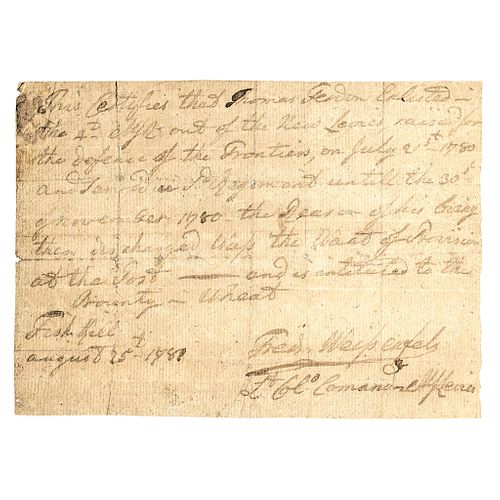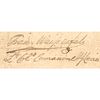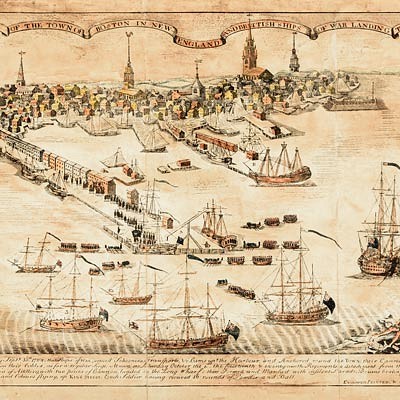1781 Revolutionary War FREDERICK VON WEISENFELS, Signed Manuscript Document
Lot 86
Categories
Estimate:
$1,200 - $1,400
Absentee vs Live bid
Two ways to bid:
- Leave a max absentee bid and the platform will bid on your behalf up to your maximum bid during the live auction.
- Bid live during the auction and your bids will be submitted real-time to the auctioneer.
Bid Increments
| Price | Bid Increment |
|---|---|
| $0 | $10 |
| $200 | $20 |
| $300 | $25 |
| $500 | $50 |
| $1,000 | $100 |
| $2,000 | $200 |
| $3,000 | $250 |
| $5,000 | $500 |
| $10,000 | $1,000 |
| $20,000 | $2,000 |
| $30,000 | $2,500 |
| $50,000 | $5,000 |
| $100,000 | $10,000 |
| $200,000 | $20,000 |
| $300,000 | $25,000 |
| $500,000 | $50,000 |
About Auction
By Early American History Auctions
Mar 20, 2021
Set Reminder
2021-03-20 12:00:00
2021-03-20 12:00:00
America/New_York
Bidsquare
Bidsquare : Autographs-Colonial-Political-Americana
https://www.bidsquare.com/auctions/early-american-history-auctions/autographs-colonial-political-americana-6509
330 Lots of Rare, Historic Autographs, Americana, Civil War Era, George Washington, Abraham Lincoln, Slavery & Black History, Revolutionary War Era, Colonial America, Federal Period, War of 1812, Colonial Currency, Indian Peace Medals & more... Early American History Auctions auctions@earlyamerican.com
330 Lots of Rare, Historic Autographs, Americana, Civil War Era, George Washington, Abraham Lincoln, Slavery & Black History, Revolutionary War Era, Colonial America, Federal Period, War of 1812, Colonial Currency, Indian Peace Medals & more... Early American History Auctions auctions@earlyamerican.com
- Lot Description
Autographs
1781 Revolutionary War "Frederick Weisenfels" Signed Manuscript Document, Society of Cincinnati Member
(BARON) FREDERICK Von WEISENFELS (c. 1738-1806). Leading soldier in the service of the Continental Army in the American Revolutionary War and Original Member from New York State of The Society of Cincinnati in 1783.
August 25th, 1781-Dated Revolutionary War Period, Manuscript Document Signed, "Frederick Weisenfels, Lt. Col. Commanding," at Fishkill (New York), Fine. This is an original Field written, Certification of Continental Army Service for Thomas Ferdon of the 4th New York Regiment. He is in charge of the "New Levies raised," (being the accumulation and assessment of new Army recruits). This Handwritten and Signed Document reads, in full:
"This Certifies that Thomas Ferdon Enlisted in the 4th NYR out of the New Levies raised for the defence of the Frontiers, on July 21st 1780 and served in s(ai)d Regiment until the 30th of November 1780. the Reason of his being then discharged was the Want of Provisions at that Post --- and is intitled to the Bounty Wheat. ---- Fishkill August 25th-1781 - (Signed) Frederick Weisenfels, Lt. Col Commanding".
This document measures 4.75" x 6.5" and is well written in fairly light brown on "PROP(ATRIA)" watermarked laid period paper, having some wear, remains quite clean with some expected folds and fully readable. The reason of his being discharged was the "want of provisions at that Post." This rare document is Signed by Frederick Weisenfels, as Lt. Col. Commanding the Levies and former Colonel of the 4th New York Regiment. We have never previously offered any item either Signed by Frederick Weisenfels and/or noted as a New York Revolutionary War document, "for the Defence of the Frontiers".
Frederick Weisenfels was commissioned a lieutenant in the Royal American Regiment of Foot also known as the 62nd (Royal American) Regiment and the Kings Royal Rifle Corps, on Feb. 23, 1756.
he creation of the regiment by Parliament was unique in that it allowed for "a certain number of foreign Protestants, who have served abroad as officers or engineers, to act and rank as officers or engineers in America only..." About fifty officers' commissions were given to Germans and Swiss.
Weissenfels was one of these. In 1757, the unit was renumbered as the 60th Royal American Foot. Weissenfels served in this regiment for four years. He fought in the French and Indian War during the battles of Qubec City at the Plains of Abraham, Ticonderoga and Havana.
Weissenfels took an Oath of Allegiance to Great Britain on December 20, 1763. That same year, he settled in Dutchess County, New York with a British military pension of half pay.
According to a short biography produced by his daughter, Harriet Weissenfels Baker, in an attempt to obtain compensation for her father's monetary losses resulting from his service in the American Revolution she reported that, "Following his principles rather than the advice of friends, he early joined the side of the revolutionaries in the American Revolutionary War."
He was commissioned a Captain in the First New York on June 28, 1775, commissioned lieutenant-colonel of the 3rd New York on March 8, 1776, became a lieutenant colonel of the 2nd New York on Nov. 21, 1776, and lieutenant colonel Commandant of the 4th New York on January 13, 1779.
His first expedition was the 1775 Battle of Quebec. He fought at White Plains, Trenton, Saratoga and Monmouth. He accompanied General John Sullivan's expedition against the Iroquois in 1779 and fought at Newtowne.
On January 1, 1781, Weissenfels was released from his service to the State of New York in a reduction in force. However, in April 1782, New York raised two regiments of Levies to defend the state's northern frontier (Mohawk Valley) from Canadian irregulars and their Native American allies. The American forces were under the overall command of Colonel Marius Willet, with whom Weissenfels had served earlier in the war.
n July 1781, Willet and Weissenfels led the militia in the Battle of Sharon Springs where they ambushed a force of Indians and Loyalists under the command of John Doxtader. In October, they led the militia against a mixed force under the command of Major John Ross at the Battle of Johnstown. Afterwards, the Americans marched to German Flatts as their scouts tracked the retreating force. A forced march through a heavy snowstorm brought the militia within two miles of the Loyalist camp by nightfall of October 29, but Willet decided against a night attack in the storm. Attacking the next morning, they found that the Loyalists had already broken camp, and they eventually escaped.
In late 1781, several companies of New Hampshire troops were added to Willet's command. In February, 1783, George Washington directed Willet to capture Fort Ontario, but the Americans gave up the attempt when the possibility of surprise was lost.
Washington visited the Mohawk valley in 1783 and he instructed Willett to improve the roads and waterway to Lake Oneida. In October, Willett's and Weissenfels' troops went home after being disbanded without ceremony. Weissenfels retired from service on Jan. 1, 1784. He was an Original Member of The New York State Society of Cincinnati in 1783.
The Province of New York was a major battleground of the Revolution; New Yorkers joined in the fight for American independence, providing several regiments of troops, and notable leaders like John Lamb, Alexander McDougall, Alexander Hamilton, and Marinus Willett.
Our Auction Contents:
Black History & Slavery: (Lots 1 - 63)
Abraham Lincoln Related: (Lots 64 - 74)
Historic Autographs: (Lots 75 - 235)
Colonial America: (Lots 236 - 261)
Revolutionary War: (Lots 262 - 304)
George Washington Related: (Lots 305 - 306)
Early American Guns & Weapons: (Lots 307 - 318) - Shipping Info
-
Early American provides in-house worldwide shipping. Please contact us directly if you have questions about your specific shipping requirements.
-
- Buyer's Premium



 EUR
EUR CAD
CAD AUD
AUD GBP
GBP MXN
MXN HKD
HKD CNY
CNY MYR
MYR SEK
SEK SGD
SGD CHF
CHF THB
THB













